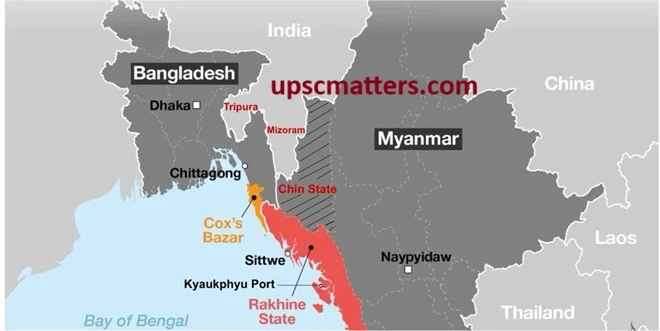The Rakhine State (formerly Arakan State) in Myanmar has long been a region of conflict. The Rakhine crisis involves tensions between the Arakan Army (AA), Myanmar’s military (Tatmadaw), and Rohingya groups. It has significant regional implications, particularly for India and Bangladesh, in terms of security, economic interests, and humanitarian concerns. As violence intensifies, its impact on India’s northeastern states, border security, and strategic connectivity projects cannot be ignored.
Rakhine: The Epicenter of Conflict and Strategy
- Location & Geography– Rakhine State is a coastal region in western Myanmar, bordering Bangladesh and the Bay of Bengal. It serves as a critical geopolitical hub due to its strategic access to international trade routes and natural resources.
- Ethnic Composition- The region is home to multiple ethnic groups, including Rakhine Buddhists, Rohingya Muslims, and other minority communities. Ethnic tensions have existed for decades, often leading to violent confrontations.
- Strategic Importance-Rakhine State is central to several international projects, such as:
-China’s Kyaukphyu deep-sea port and energy pipeline, part of the Belt and Road Initiative (BRI).
-India’s Kaladan Multi-Modal Transit Project, crucial for improving connectivity with its northeastern states.

The Rohingya Dilemma: Stateless and Forgotten
- Historical Background- The Rohingya are a stateless Muslim ethnic group from Rakhine. Myanmar’s government considers them illegal immigrants, despite their presence for centuries. The 1982 Myanmar Citizenship Law stripped them of citizenship, exacerbating their plight.
In 1982, Rohingya were not recognized as one of the 135 official ethnic groups in Myanmar and were barred from citizenship and basic human rights, effectively rendering them stateless. Buddhists in Myanmar believe that Rohingya are Bengali who migrated to Myanmar illegally during the British rule in the subcontinent. - Major Crisis Events
2012 & 2017: The Myanmar military launched violent crackdowns, leading to mass displacement. Over 1 million Rohingya fled to Bangladesh, where they now live in overcrowded refugee camps in Cox’s Bazar. Militant factions like Arakan Rohingya Salvation Army (ARSA) emerged, raising regional security concerns.
Arakan Army: Myanmar’s Emerging Power Player
- Who Are They?-
The Arakan Army (AA) is a Rakhine Buddhist insurgent group fighting for autonomy from Myanmar’s central government.
Established in 2009, it has grown into a formidable force, challenging the Myanmar military. - Why It Matters?-
Controls parts of Rakhine State and engages in clashes with the Myanmar army.
Establishes bases in Bangladesh’s Chittagong Hill Tracts (CHT), straining Dhaka’s security.
Involved in illicit trade, arms smuggling, and border conflicts.
Chin State: Another Front in Myanmar’s Crisis
Located north of Rakhine, Chin State shares a border with India’s Mizoram and is home to the predominantly Christian Chin ethnic group. The region has seen intensified resistance against Myanmar’s military junta, with the Chinland Defense Force (CDF) actively fighting for autonomy. The conflict has caused thousands of refugees to flee into India, putting pressure on Mizoram’s resources and security infrastructure. Like Rakhine, Chin State’s instability directly impacts India’s border security and strategic interests.
Bangladesh’s Challenges Amid the Rakhine Crisis
- Security Concerns– The presence of the Arakan Army in Bangladesh leads to border clashes. Rising threats from ARSA and extremist elements in Rohingya camps.
- Strain on Resources- Bangladesh hosts over a million Rohingya refugees, causing economic, environmental, and social strains. The repatriation process remains stalled, leaving Dhaka burdened with humanitarian responsibilities.
India at Crossroads: Balancing Security, Strategy, and Diplomacy
- Security Concerns- Spillover of militant activities into India’s Northeast (Mizoram, Manipur, Nagaland). Risk of Rohingya radicalization, with potential links to terror networks.
- Impact on India’s Northeast Insurgency- Myanmar has been a buffer against Indian rebel groups (NSCN-K, ULFA, PLA). Instability may allow these insurgents to strengthen their bases. Some radical Islamist groups in Bangladesh and Pakistan could exploit the situation, leading to terrorist activities against India.
- Rising Threat of Radicalization and Terrorism– Reports indicate that groups like Jamaat-ul-Mujahideen Bangladesh (JMB) and Harkat-ul-Jihad-al-Islami (HuJI) have tried to recruit Rohingya refugees for extremist activities. Pakistan could exploit the situation, leading to terrorist activities against India.
- Economic and Strategic Setbacks- India’s Kaladan Multi-Modal Transit Project is threatened. Growing Chinese influence in Myanmar challenges India’s Act East Policy.
The Role of Global Powers: China and the United States
- China’s Expanding Footprint
-China’s Belt and Road Initiative (BRI) investments in Myanmar, particularly in the Kyaukphyu deep-sea port, enhance Beijing’s strategic leverage.
-The Chinese government maintains close ties with both the Myanmar military and the Arakan Army, ensuring its interests remain safeguarded.
-This increasing dependence on China marginalizes India’s influence and challenges New Delhi’s Act East Policy. - The U.S. Approach and Its Implications
-The United States has imposed sanctions on Myanmar’s military over human rights violations. It advocates for democracy and ethnic reconciliation, supporting groups opposed to military rule.
-However, Washington’s direct influence on the crisis remains limited, mainly through diplomatic pressure and humanitarian aid. - India’s Balancing Act
-India must navigate a careful path between maintaining relations with Myanmar’s government, engaging with the U.S. on regional stability, and countering Chinese influence.
-Strengthening trilateral cooperation with Bangladesh and ASEAN nations can help India mitigate security risks and promote stability in the region.
India’s Strategy: Securing Borders and Strengthening Influence
- Strengthen Security Cooperation
Improve intelligence-sharing with Bangladesh and Myanmar.
Deploy better border security measures.
Conduct joint counter-terrorism operations. - Accelerate Infrastructure Projects
Expedite the Kaladan project for better regional connectivity.
Increase investments in Bangladesh, reinforcing diplomatic ties. - Diplomatic Engagement
Push for a negotiated settlement between Myanmar and the Rohingya.
Support Bangladesh’s repatriation efforts while providing humanitarian aid.
Case Study: India’s Approach to Myanmar’s Insurgencies – Lessons from Operation Sunrise
Background
India has historically dealt with insurgent groups operating along its porous border with Myanmar. Several Northeast insurgent outfits, such as the NSCN-K (National Socialist Council of Nagaland-Khaplang), ULFA (United Liberation Front of Asom), and PLA (People’s Liberation Army of Manipur), have used Myanmar’s territory as a base for launching attacks against Indian security forces.
Operation Sunrise (2019-2020): A Joint Military Campaign
India and Myanmar launched Operation Sunrise to dismantle militant camps near the India-Myanmar border. The key objectives were:
- Eliminating insurgent strongholds in Myanmar’s Sagaing Region and Rakhine State.
- Cutting off supply chains used by militant groups operating in India’s Northeast.
- Strengthening border security cooperation with Myanmar’s military (Tatmadaw).
Outcomes and Strategic Gains
- Successful neutralization of several militant camps.
- Better intelligence-sharing mechanisms between India and Myanmar.
- Reduced insurgent activities along the Indo-Myanmar border, at least temporarily.
Challenges and Lessons Learned
- The fragile political situation in Myanmar affects India’s ability to conduct sustained operations.
- Growing Chinese influence over Myanmar complicates India’s long-term security cooperation.
- Insurgent groups have adapted by shifting their bases deeper into Myanmar, necessitating a continuous engagement strategy.
Relevance to the Current Rakhine Crisis
- The Rakhine crisis could trigger a resurgence of armed groups along India’s Northeast.
- The Arakan Army’s activities could create spillover effects similar to past insurgencies.
- India needs to maintain proactive engagement with Myanmar to prevent militant groups from using its territory for cross-border attacks.
The Rakhine crisis is a complex geopolitical challenge affecting regional stability. India must carefully balance security concerns, economic ambitions, and humanitarian responsibilities. By engaging proactively in diplomacy, regional security, and infrastructure development, India can safeguard its interests while contributing to peace in the region.
If you found this helpful, you might also like these articles:
📌 [ https://upscmatters.com/why-shaikh-hasina-left-bangladesh/]
📌 [https://upscmatters.com/india-china-relations/ ]
They cover key concepts that will boost your preparation! 🚀
📢 Stay Updated with the Best UPSC Resources!
Join our Telegram Channel for:
✅ Daily Current Affairs
✅ Important Notes & PDFs
✅ Answer Writing Tips
✅ Strategy & Motivation
📲 Click the link to join now: [https://t.me/upscmatters]
Don’t miss out on valuable updates! 🚀
To enhance your understanding here are some external links-
Understanding the Rakhine State and Its Importance-Detailed information on the ethnic composition and strategic importance of Rakhine State can be found on the Rakhine State – Wikipedia page.
Who Are the Rohingya? The Root of the Crisis-For historical context and major events related to the Rohingya crisis, consult the Rohingya people – Wikipedia page.
Arakan Army (AA): A Rising Rebel Group– In-depth information about the Arakan Army, including its objectives and activities, is available on the Arakan Army – Wikipedia page.
Bangladesh’s Challenges Amid the Crisis– Insights into Bangladesh’s security concerns and the strain on resources due to the refugee influx can be found in reports by Human Rights Watch and the International Crisis Group.


2 thoughts on “Rakhine Crisis: A Geopolitical Flashpoint”